"Swaziland Regions | South East Swaziland"
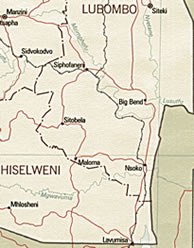
![]() The South East Region of Swaziland covers the Route from the border post Golela/Lavumisa to Manzini and
the surrounding area.
This is the main entry point for those entering Swaziland from Kwazulu
Natal and is a major route into the Kingdom. It is one of the entry points used
by many motorists wishing to travel through Swaziland to Mozambique or the Kruger
Park in Mpumalanga.
The South East Region of Swaziland covers the Route from the border post Golela/Lavumisa to Manzini and
the surrounding area.
This is the main entry point for those entering Swaziland from Kwazulu
Natal and is a major route into the Kingdom. It is one of the entry points used
by many motorists wishing to travel through Swaziland to Mozambique or the Kruger
Park in Mpumalanga.
A kilometer outside Lavumisa one would turn left to travel to Nhlangano.
This is an exceptionally scenic route, along the border, on a recently completed
tar road. Many a traveler uses this route to the South West of Swaziland rather
than driving on the South African side of the border to Mahamba.
The road through Big Bend to Manzini and Mbabane or Siteki, is fully
tarred and passes through the Swaziland Lowveld. The road from Lavumisa to
Big Bend runs along the bottom of the Lebombo Mountains which is the border
with Kwazulu Natal. The Swaziland Lowveld is typical savannah, thorn trees
and grasslands.
Big Bend, so named after the bend in the Usutu River, is a Village
centered on the Ubombo Sugar Estate. Ten kilometers before Big Bend one will
find the Riverside Motel which overlooks the Usutu River. In Big Bend there
is a hotel as well as a bed and breakfast facility. Ubombo Sugar Ltd grows,
mills and refines sugar for both the domestic and export market. The 45 bed
hospital is maintained by the Company and provides medical care for both the
staff and local residents. Excellent sporting facilities exist at the Ubombo
Country Club, which include golf, tennis and squash.
The Van Eck Dam, in Big Bend, is the ideal camping ground for the fisherman
as well as the bird watcher. The dam is surrounded by a game park and one
can watch the animals grassing along the shore line. Permission is required
to drive around the park. The dam has the renowned fighting tiger fish,
barbel and bream. The official record tiger caught is 6.3kgs but one of
7.5 and 7.2kgs has been caught. One can also sail or water ski on the dam.
One cannot swim in the dam because of the crocodiles.
The journey from Big Bend to Manzini is on a fully tarred road and goes
through cattle ranches and the tribal agricultural land before climbing up to
Manzini. One drives through an area of Granite Kopjies with their spectacular
balancing rocks and then rolling hills before Manzini.
At Phuzumoya, “Eat air”, is the turn off to Mkaya Game Reserve, the Kingdoms
VIP’s destination. The park is only accessible by park vehicles so the visitor
has to leave their vehicle in secure parking at the turn off. Mkaya Game Reserve's tented
camp is woven into lush riverine vegetation with on suite showers and a loo
with a view. Vehicle excursions and guided walks with skilled rangers are
offered in the reserve. Elephant, black and white rhino, buffalo and a host
of other animals will be encountered at very close range. White water rafting
is also offered when the Usutu River is running full.
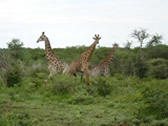
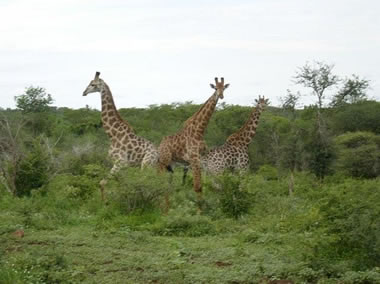
South East Swaziland | Game Reserve.
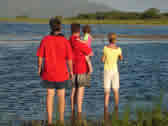

South East Swaziland | Tiger Fishing at Van Eck Dam
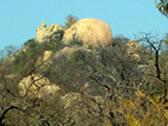
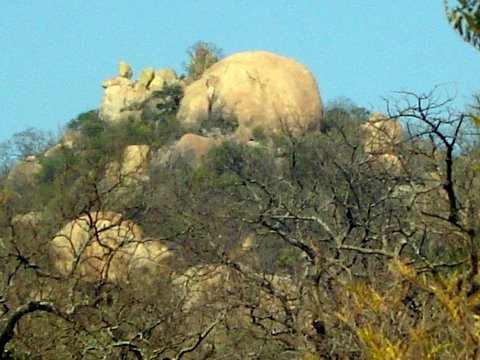
Granite Kopjies with balancing rocks
Hover over images for larger view.
Ten kilometers from Big Bend along the road to Manzini is the turn-off to Siteki. This is the route that those wishing to travel to Mozambique would take. The visitor will drive through the heart of Swaziland’s rural area before climbing up to Siteki, which is perched spectacularly on the edge of the Lebombo Mountains. The view over the plains below are nothing but spectacular, especially at sunset. Siteki is the Administrative Capital of the Lebombo Area. Siteki has the oldest Hotel in the kingdom which has recently been completely refurbished. It is the ideal night stop for those, who have towed caravans, trailers or boats all the way from Kwazulu Natal, on their way to Mozambique North. It is from here the traveler can have an early start and get through the Mhlumeni/Goba border post as it opens. Siteki is well known for its Inyanga and Sangoma School that trains healers and diviners. Tourists who make prior arrangements can have a session with one of the Sangomas. The cultural market is also well worth a visit. Muti-Muti Nature Reserve is a birdwatchers paradise with a variety of different habitats. The reserve has the moist belt forests, Kiaat woodlands, rocky plateau and cliffs and open savannah. Over 250 bird species have already been identified in the reserve. On a clear day one can see the entire breadth of Swaziland in the West and across the floodplains of Mozambique in the East.
